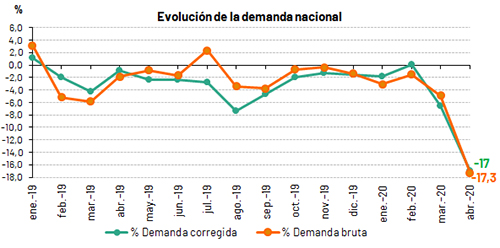Wind energy contributed 21.3% in April, concentrated solar power 1.2% and photovoltaic 6.8%.
47.9% of the monthly generation was from renewable sources and 72.6% were produced from technologies that do not emit CO2 into the atmosphere.
The demand for electrical energy decreased in the Balearic Islands by 27.6% and in the Canary Islands by 20.3% compared to the same month of 2019.

Following the usual communication schedule on the evolution of the demand for electrical energy, Red Eléctrica de España publishes the one corresponding to the month of April, the first full month under the state of alarm on the occasion of COVID-19, in which maintained the decline in economic activity that started on March 15. In this context, the national electricity demand for April is estimated at 17,104 GWh, 17.3% lower than that registered in the same month of the previous year. If the effects of the calendar and temperatures are taken into account, the figure decreases 17% compared to April 2019.
In the first four months of 2020, demand is estimated at 82,737 GWh, 6.5% less than in 2019. In this case, once the influence of calendar and temperatures has been corrected, demand is 6.2% lower than that registered in the same period of the previous year.
In the month of April and according to data estimated today, generation from renewable energy sources represented 47.9% of production. From January to April, renewable generation reaches 45.3% of the total electricity balance.
In this month, 72.6% of electricity production came from technologies that do not emit CO2.
With information available today, wind power production in April reached 3,730 GWh, which is 20% less than the same period last year, and accounted for 21.3% of national production.

The demand for electrical energy falls 17% in the peninsular electricity system
In the peninsular electricity system, the demand for April is estimated at 16,191 GWh, 17% lower than that registered in the same month of the previous year. If the effects of the calendar and the temperatures are taken into account, the demand is 16.7% lower than that of April 2019.
In the first four months of 2020, the demand for electrical energy in the Peninsula is estimated at 78,319 GWh, 6.4% less than in 2019. In this case, once the influence of calendar and temperatures has been corrected, demand it is 6.2% lower than that registered in the same period of the previous year.
During this month and according to estimated data today, 49.7% of the peninsular generation was of renewable origin and 75.7% came from technologies that do not emit CO2. For its part, wind registered 3,672 GWh, 20.1% lower than in April last year, and contributed 22% to the mix.
Demand for electrical energy falls 27.6% in the Balearic Islands and 20.3% in the Canary Islands in April
In the Balearic Islands, the demand for electrical energy in April is estimated at 323,296 MWh, 27.6% lower than that registered in the same month of the previous year. If the effects of the calendar and temperatures are taken into account, the figure decreases 27.6% compared to April 2019. In the first four months of 2020, Balearic demand is estimated at 1,586,386 MWh, a 10, 7% less than in 2019.
The combined cycle, with 78.3% of the total, was the first source of electricity generation in the Balearic Islands, where renewable technologies that do not emit CO2 represented 6.4%. Coal did not produce a single MWh during the month of April, a trend that has been maintained since the beginning of the year in the Balearic electricity system.
For its part, in the Canary archipelago the demand for electricity is estimated at 558,619 MWh, 20.3% lower than that registered in April 2019. If the effects of the calendar and temperatures are taken into account, the figure decreases by 20 , 2% with respect to the same month of the previous year. So far in 2020, demand in the Canary Islands is estimated at 2,701,096 MWh and falls 6% compared to the same period of the previous year.
In April and according to estimated data, the combined cycle was the leading technology in the Canary Islands generation mix, with a contribution of 45.3%. Renewables and emission-free technologies represented 14.3% of Canarian generation.